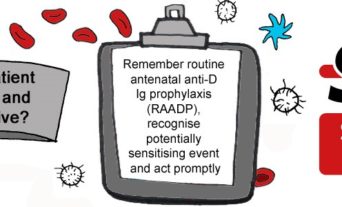2015 saw the start of a new focus on maternity services, initially precipitated by the publication of a report into systemic failures of care in Morecambe Bay.1 Significant harm to babies and mothers caused public concern; within a few months, the Department of Health (DH) had published its ambition to halve stillbirths and neonatal deaths by 2030,2 and commissioned a national review of maternity services, which published its report, Better Births, the following year.3
New policies resulting in improvement
Over the succeeding five years, policy initiatives were introduced to promote change. Saving Babies’ Lives from NHS England identified measures to improve maternity safety,4 the Royal College of Obstetricians and Gynaecologists introduced Each Baby Counts, an audit of maternity outcomes,5 a Maternity Transformation Programme was established to implement the recommendations of Better Births, and DH published two follow-up progress reports under the title of Safer Maternity Care.2,6
Stillbirths have decreased by 25% (per thousand total births) since 2010, roughly on track to meet the national ambition.
These changes have been credited with contributing to improvements in perinatal mortality.7 Stillbirths have decreased by 25% (per thousand total births) since 2010, roughly on track to meet the national ambition. Neonatal deaths have followed a more complex pattern, with an initial rise associated with more very early births being classified as neonatal deaths instead of miscarriages as previously, but neonatal deaths in babies born over 24 weeks have decreased by 10% (per thousand live births).7 There is more to do to achieve the national ambition, but both elements of perinatal mortality are improving overall.
Further cause for concern
This is, however, far from the complete picture. Despite the overall improvements, there have been further alarming failures of individual maternity units, most notably in Shrewsbury and Telford,8 and an independent investigation has been commissioned into East Kent maternity services.9 Given that the prompt for the initiatives to improve maternity services was a failing maternity unit in Morecambe Bay, this is a significant concern. Many of the findings of the interim Shrewsbury and Telford investigation report are very reminiscent of the failings described five years previously at Morecambe Bay.
The performance of clinical units follows an approximately normal distribution,10 with most grouped centrally around the mean and smaller numbers in each tail, either outstandingly good or bad. It seems highly likely that the improvements in maternity outcomes have been achieved through changes in the central majority, but this has not affected those units in the poorly performing tail, at least to the same extent. It may be that the policies are not well adapted to those units, or perhaps they are unwilling or unable to follow suit. There has been no discernible decline in the occurrence of maternity scandals despite the overall improvement in services.
More changes needed
Effective early warning system
To change this depressing situation, the first requirement is to have early warning of which units are at risk. It is evident, however, that the earliest warning of most poorly performing units comes from families who have been harmed by failures of care.1,8 It is further evident that in many of the most egregious instances those families have not been listened to initially, but have been fobbed off, ignored and misled, and have required great persistence and courage before their voices have belatedly been heeded. It seems that for some units, reputation management still has a higher priority than openness and honesty when something has gone wrong.
It is unlikely that high-level statistics, such as perinatal mortality, can provide an effective early warning of such units because appreciable numbers of avoidable adverse outcomes are easily swamped by higher numbers that were inevitable. Although more sensitive indicators are available, such as intrapartum stillbirth, unexpected early neonatal death and brain injury, the analysis of unit-based outcomes for maternity care is still rudimentary compared with other specialties.10
Further, self-reporting and external inspections are rarely helpful in identifying poor unit performance. Recurring features found in independent investigations include dysfunctional teamwork, closed organisational cultures and poor leadership, resulting in lack of recognition, reporting and investigation of incidents and failure to learn from them.1,8 This underpins the rejection of families who want answers to why harm has occurred, but it also makes external recognition of seriously dysfunctional organisational performance problematic, whether by NHS England or the Care Quality Commission.
Each Baby Counts
There is an obvious source of information, very relevant to poorly performing units but, because of their nature, it is particularly likely to be suppressed: the deaths of babies otherwise expected to survive. ‘Babies born at 37 weeks and who are alive in labour (without significant congenital anomaly) should be born in good condition and go home with mum and family.’5 The corollary is that any death of such a baby should generate full investigation to find out why and what should change to prevent recurrence. A high proportion will be found in which different clinical care could have led to a different outcome − 74% in the RCOG’s Each Baby Counts audit 5 − and intrapartum stillbirths are particularly likely to be preventable.11
Babies born at 37 weeks and who are alive in labour (without significant congenital anomaly) should be born in good condition and go home with mum and family.
In a well-run unit, of course, disclosure and investigation are exactly what happens, but reports into poorly performing maternity services consistently find a different pattern. Unexpected deaths may at best be poorly investigated with no learning or, at worst, not even reported as safety incidents. They are, in effect, written off as inevitable because, in the words of one clinician, ‘bad things happen in maternity – people just have to accept it’.1 It may seem surprising that the death of a healthy individual expected to survive can be brushed aside so easily, but the fact is that the safeguards that would prevent it in an adult or older child are lacking for perinatal infants.
More investigation needed after stillbirth and early death
Many of these babies are stillborn, so formally regarded as having had no separate existence; coroners have no remit to require an investigation or jurisdiction to hold an inquest. Not only does this mean that there is no backstop to ensure that these deaths are properly investigated, it also generates an incentive to record early neonatal deaths as stillbirths. Yet in non-malformed term babies, the great majority of causes of intrapartum stillbirth are the same as the causes of early neonatal death, with hypoxia and brain injury predominating. The pulmonary and cardiovascular changes that occur immediately after birth, while physiologically profound, do not change the pathology of the term neonate without congenital anomaly. The concept of no separate existence prior to the first breath remains legalistic, not pathophysiological.
Those babies born alive after severe hypoxia in labour who subsequently die of the effects may not attract the attention of coroners either. Most will have been through a full gamut of resuscitative and interventional procedures by one or more neonatal teams, and by the time that active treatment is abandoned the outcome will commonly be regarded as an expected death. So it was, from the perspective of the neonatal teams, but it was entirely unexpected from the perspective of a term baby without congenital anomaly, and it should be investigated as such. However, poorly performing units typically show little enthusiasm for drawing the coroner’s attention to the prior events.
Independent scrutiny and scope for expansion of medical examiner input
The introduction of medical examiners offers a clear opportunity to ensure that these cases are not lost and can be learned from and, where necessary, instances of systemic failure can be identified. To achieve this, medical examiners will need to retain sufficient independence and remain aware that deaths that appear inevitable after a fraught neonatal course may have been entirely avoidable if the management of labour and delivery had been different. Further, stillbirths are not currently within the remit of medical examiners, an inexplicable omission despite previous recommendation. The scope of medical examiners should include at least the stillbirth of all non-malformed babies born at 37 weeks gestation or more.The introduction of medical examiners offers a clear opportunity to ensure that these cases are not lost and can be learned from and, where necessary, instances of systemic failure can be identified.
Better independent scrutiny of all unexpected perinatal deaths would be a very significant step forward, helping to identify poorly performing services before they cause scandals and contributing to the national ambition to improve maternity safety.




